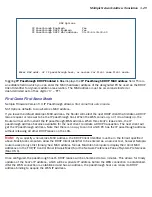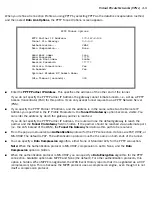
Multiple Network Address Translation 3-33
Select
Show/Change Public Range
, then
Easy-PAT Range
, and press Return. Enter the value your ISP assigned
for your public address (206.1.1.6, in this example). Toggle
Type
to pat. Your public address is then mapped to
the remaining private IP addresses using PAT. (If you were not using the Easy-PAT Range and Easy-PAT List that
are created by default by using Easy Setup, you would have to
define
a public range and map list. For the
purpose of this example you can just
alter
this range and list.)
Select
CHANGE NAT PUBLIC RANGE
and press Return. This returns you to the Network Address Translation
screen.
Select
Add Public Range
and press Return. Type a name for this static range, as shown below. Enter the first
and last public addresses your ISP assigned in their respective fields as shown. The first five public IP
addresses (206.1.1.1 - 206.1.1.5, in this example) are statically mapped to the first five corresponding private
IP addresses (192.168.1.1 - 192.168.1.5).
Change NAT Public Range
Range Name: Easy-PAT Range
Type... pat
Public Address: 206.1.1.6
First Public Port: 49152
Last Public Port: 65535
CHANGE NAT PUBLIC RANGE CANCEL
Add NAT Public Range
Range Name: Static Range
Type... static
First Public Address: 206.1.1.1
Last Public Address: 206.1.1.5
ADD NAT PUBLIC RANGE CANCEL
Return/Enter to commit changes.
Summary of Contents for 4000 Series
Page 10: ...x Firmware User Guide Packet header types B 14 Appendix C Binary Conversion Table C 1 Index ...
Page 18: ...1 8 Firmware User Guide ...
Page 66: ...2 48 Firmware User Guide ...
Page 102: ...3 36 Firmware User Guide ...
Page 130: ...4 28 Firmware User Guide ...
Page 206: ...7 18 Firmware User Guide ...
Page 224: ...9 14 Firmware User Guide ...
Page 274: ...10 50 Firmware User Guide ...
Page 314: ...Index 6 ...






























